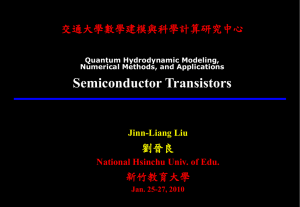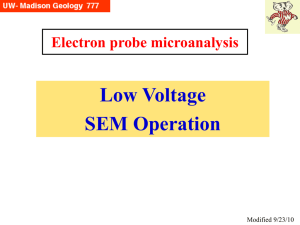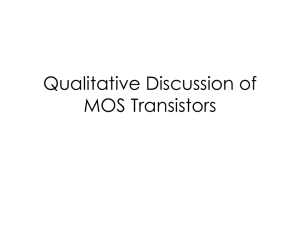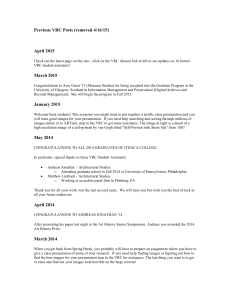Measurement of the Charge of and Electron
advertisement
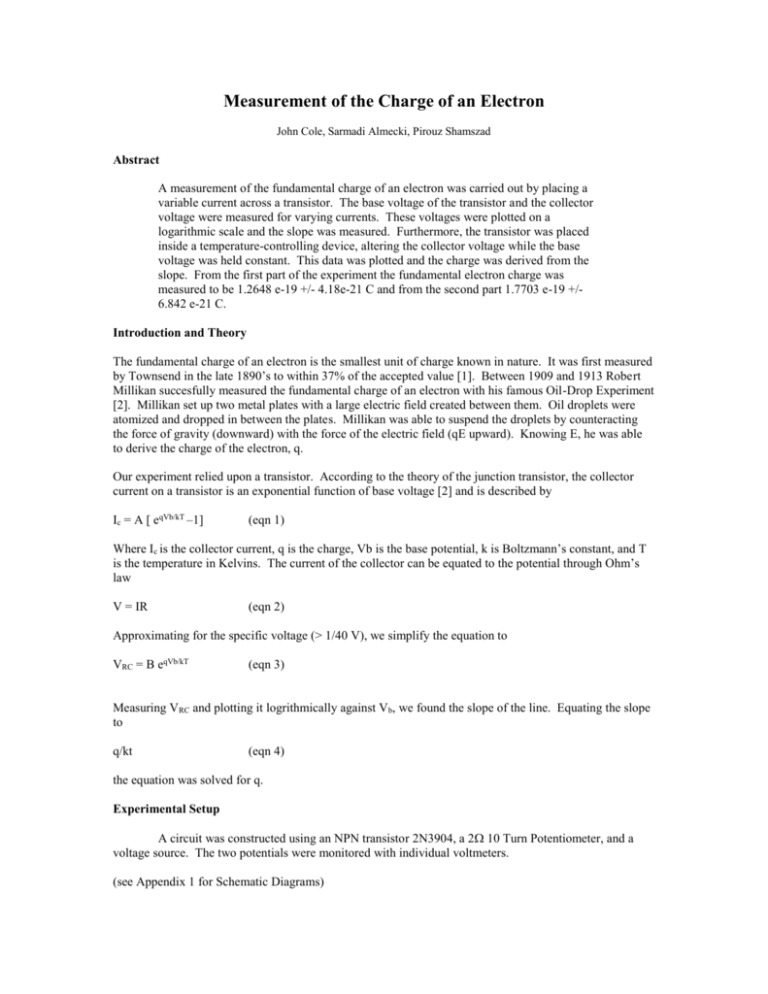
Measurement of the Charge of an Electron John Cole, Sarmadi Almecki, Pirouz Shamszad Abstract A measurement of the fundamental charge of an electron was carried out by placing a variable current across a transistor. The base voltage of the transistor and the collector voltage were measured for varying currents. These voltages were plotted on a logarithmic scale and the slope was measured. Furthermore, the transistor was placed inside a temperature-controlling device, altering the collector voltage while the base voltage was held constant. This data was plotted and the charge was derived from the slope. From the first part of the experiment the fundamental electron charge was measured to be 1.2648 e-19 +/- 4.18e-21 C and from the second part 1.7703 e-19 +/6.842 e-21 C. Introduction and Theory The fundamental charge of an electron is the smallest unit of charge known in nature. It was first measured by Townsend in the late 1890’s to within 37% of the accepted value [1]. Between 1909 and 1913 Robert Millikan succesfully measured the fundamental charge of an electron with his famous Oil-Drop Experiment [2]. Millikan set up two metal plates with a large electric field created between them. Oil droplets were atomized and dropped in between the plates. Millikan was able to suspend the droplets by counteracting the force of gravity (downward) with the force of the electric field (qE upward). Knowing E, he was able to derive the charge of the electron, q. Our experiment relied upon a transistor. According to the theory of the junction transistor, the collector current on a transistor is an exponential function of base voltage [2] and is described by Ic = A [ eqVb/kT –1] (eqn 1) Where Ic is the collector current, q is the charge, Vb is the base potential, k is Boltzmann’s constant, and T is the temperature in Kelvins. The current of the collector can be equated to the potential through Ohm’s law V = IR (eqn 2) Approximating for the specific voltage (> 1/40 V), we simplify the equation to VRC = B eqVb/kT (eqn 3) Measuring VRC and plotting it logrithmically against Vb, we found the slope of the line. Equating the slope to q/kt (eqn 4) the equation was solved for q. Experimental Setup A circuit was constructed using an NPN transistor 2N3904, a 2 10 Turn Potentiometer, and a voltage source. The two potentials were monitored with individual voltmeters. (see Appendix 1 for Schematic Diagrams) The experiment was repeated using a heat pump (see Appendix 1) in order to alter the temperature. The device allowed the transistor to be cooled and heated while keeping Vb constant. Procedure and Data The circuit was constructed as shown above and wired to a 24-volt power source. Turning the potentiometer varied the potential of the emitter and voltages were measured at methodically spaced intervals. Systematic error arose from the voltmeters: the voltmeter measuring the base potential was accurate only to 1/100 of a volt and the voltmeter on the collector was accurate up to 1/1000 of a volt. Vb (volts) Vrc (volts) 0.5023 0.5075 0.5257 0.5438 0.5548 0.5623 0.5684 0.5865 0.5967 0.6041 0.6099 0.6145 0.6186 0.6222 0.625 0.6287 0.634 0.6351 0.6371 0.084 0.1 0.2 0.4 0.6 0.8 1 2 3 4 5 6 7 8.02 9 10.25 12.5 13.01 14 The resulting data was tabulated and graphed with gnuplot on a logarithmic scale: Vrc vs. Vb 54.598 20.0855 'lab3_electron.dat' e/kT = 31.1452 +/- 1.03 7.38905 2.71828 1 0.36788 0.135335 0.0497872 0.5 Figure 1. 0.52 0.54 0.56 0.58 0.6 0.62 Vb -- Base to Emitter Voltage 0.64 0.66 Vrc vs. Vb 25 20 'lab3_electron.dat' f(x) e/kT = 31.1452 +/- 1.03 15 10 5 0 0.5 0.52 0.54 0.56 0.58 0.6 0.62 Vb -- Base to Emitter Voltage 0.64 0.66 Figure 2. The temperature was 294.15 K, measured with a mercury thermometer sitting in the room. After the first part of the experiment, wire was added to each of its terminals of the transistor and placed into the controlled-temperature device. While the variable resistor was held constant, the temperature was systematically changed from high to low. Temperatures were measured using a mercury thermometer. Vrc (volts) 18.86 17 15.15 13 9.38 4.39 4.18 2.28 1.443 0.8 0.7 0.39 0.18 0.155 Vrc Error (volts) +/-0.001 +/- .001 +/- .001 +/- .001 +/- .001 +/- .001 +/- .001 +/- .001 +/- .001 +/- .001 +/- .001 +/- .001 +/- .001 +/- .001 +/- .001 Vb (volts) T (C) 0.48 0.5 0.5 0.5 0.51 0.51 0.5 0.5 0.5 0.5 0.5 0.5 0.5 0.5 69 65 65 62 56 44 43 35 28 22 20.5 14 4 2 T(K) 342.15 338.15 338.15 335.15 329.15 317.15 316.15 308.15 301.15 295.15 293.65 287.15 277.15 275.15 1/T (K) 0.002923 0.002957 0.002957 0.002984 0.003038 0.003153 0.003163 0.003245 0.003321 0.003388 0.003405 0.003483 0.003608 0.003634 Vrc vs. 1/T 20 'lab3_electron_temp.dat' using 5:1 f(x) 18 16 14 12 qV(b)/k = -6411.11 +/- 247.8 10 8 6 4 2 0 0.0029 0.003 Figure 3. 0.0031 0.0032 0.0033 0.0034 0.0035 0.0036 0.0037 1/T (K^-1) Using a logarithmic scale on the x-axis produces a straight line: Vrc vs. 1/T 70 'lab3_electron_temp.dat' using 5:3 60 50 40 30 20 10 0 0.0029 0.003 Figure 4. 0.0031 0.0032 0.0033 0.0034 0.0035 0.0036 0.0037 1/T (K^-1) Interpretation and Discussion From the data gathered, we plotted Base to emitter voltage against the voltage across the collector resistor. The best-fit line was formulated using the method of least squares on gnuplot. Our resulting slope was 31.1452 +/-1.03. The equation slope = q/kt was used to derive the fundamental charge of an electron. Our data using variable potentials showed the charge of an electron is 1.2648 e-19 C with a standard deviation of +/- 4.18e-21 C. The data from the variable temperature experiment was treated similarly and gave a slope of 6411.11 +/247.8. The equation slope = qVb/k was used to derive the charge. Our data using variable temperatures showed the charge of an electron is 1.7703 e-19 C with a standard deviation of +/- 6.842 e-21 C. Our ability to accurately measure the fundamental charge was affected by the precision of our equipment. Because the voltmeters could read only to a certain degree of accuracy, a more precise calculation was unattainable. Furthermore, because we took only one set of data, we were able to do limited statistical analysis. Furthermore, the thermometer used to determine the temperature of the room and the transistor was precise to only a single degree Celsius. Most of the error in our experiment came from our lack of independent data and the limitations of our equipment. Conclusion In summary, the charge first accurately measured by Millikan was measured by comparing the potentials across a transistor. We measured the average of the two charges to be 1.3175 e-19 +/- 5.511e-21 C. The sources of systematic error were significant, mostly resulting from the limitations of the instruments. Our data was 18% within the accepted value of the charge of an electron. Improvements on the experiment should focus on more precise equipment. Independent sets of data should be taken to statistically improve the final value. Finally, students performing the experiment should take special care to employ neatness and orderliness in their circuit construction to save time in the experimental setup. [1] Serway, R.A, Physics for Scientists and Engineers(Edition Four) 1982. Saunders College Publishing, 1982. [2] Beer, Dr. L Neel. Keithley Instruments, Inc. 1983. Appendix 1 Schematic Diagram of the Circuit Constructed


